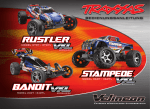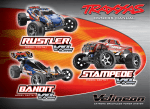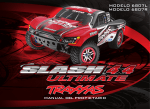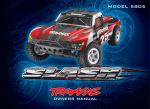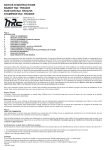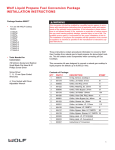Download Traxxas 3607L User's Manual
Transcript
owners manual MODEL 3707 / 3707L MODEL 3607 / 3607L MODEL 2407 / 2407L extreme brushless power system INTRODUCTION 3 BEFORE YOU PROCEED 3SAFETY PRECAUTIONS 6 BANDIT VXL OVERVIEW 7 STAMPEDE VXL OVERVIEW 8 RUSTLER VXL OVERVIEW 9 TOOLS, SUPPLIES AND REQUIRED EQUIPMENT 10 QUICK START: GETTING UP TO SPEED 11 TRAXXAS TQi RADIO AND VELINEON POWER SYSTEM 20 ADJUSTING THE ELECTRONIC SPEED CONTROL 22 DRIVING YOUR MODEL 24 BASIC TUNING ADJUSTMENTS 26MAINTAINING YOUR MODEL 27 ADVANCED TUNING ADJUSTMENTS 29 TQi ADVANCED TUNING GUIDE Thank you for purchasing a Traxxas electric model equipped with the new Velineon® Brushless Power System. This manual covers the Rustler® VXL Stadium race truck, the Bandit™ VXL buggy and the Stampede® VXL monster truck. The Velineon Power System lets you experience the best that brushless motor technology has to offer. Incredible speed, efficient operation, long run times, and lowmaintenance operation are just some of the benefits. No matter which model you have selected, we are confident you will be rewarded with high-speed performance in a durable, long-lasting product. This manual contains the instructions you will need to operate and maintain your model so that you can enjoy it for years to come. We want you to feel confident that you own one of the best-performing models in the market and that it is backed by a team of professionals who aim to provide the highest level of factory support possible. Traxxas models are about experiencing total performance and satisfaction, not just with your model, but also with the company that stands behind it. We know you’re excited about getting your new model on the road, but it’s very important that you take some time to read through the Owner’s Manual. This manual contains all the necessary set-up and operating procedures that will allow you to unlock the performance potential that Traxxas engineers designed into your model. Also be sure to read and follow the precautions and warnings in this manual and on any labels or tags attached to your model. They are there to educate you on how to operate your model safely and also get maximum life and performance from your model. Even if you are an experienced R/C enthusiast, it’s important to read and follow the procedures in this manual. Thank you again for going with Traxxas. We work hard every day to assure you receive the highest level of customer satisfaction possible. We truly want you to enjoy your new model! Traxxas Support Traxxas support is with you every step of the way. Refer to the next page to find out how to contact us and what your support options are. Quick Start This manual is designed with a Quick Start path that outlines the necessary procedures to get your model up and running in the shortest time possible. If you are an experienced R/C enthusiast you will find it helpful and fast. Be sure and read through the rest of the manual to learn about important safety, maintenance, and adjustment procedures. Turn to page 10 to begin. REGISTERING YOUR MODEL In order to serve you better as our customer, please register your product within 10 days of your purchase online at Traxxas.com/register. Traxxas.com/register FCC Compliance This device contains a module that complies with the limits for a Class B digital device as described in part 15 of the FCC rules. Operation is subject to the following two conditions: (1) This device may not cause harmful interference, and (2) this device must accept any interference received, including interference that may cause undesired operation. The limits for a Class B digital device are designed to provide reasonable protection against harmful interference in residential settings. This product generates, uses and can radiate radio frequency energy, and, if not operated in accordance with the instructions, may cause harmful interference to radio communications. The user is cautioned that changes or modifications not expressly approved by the party responsible for compliance could void the user’s authority to operate the equipment. Canada, Industry Canada (IC) This Class B digital apparatus complies with Canadian ICES-003 and RSS-210. This device complies with Industry Canada license exempt RSS standard(s). Operation is subject to the following two conditions: This device may not cause interference, and this device must accept any interference, including interference that may cause undesired operation of the device. Radio Frequency (RF) Exposure Information The radiated output power of the Traxxas LP Device is below the Industry Canada (IC) radio frequency exposure limits. The antenna for this transmitter must not be co-located with any other transmitters except in accordance with FCC and Industry Canada multi-transmitter procedures. Co-location means having a separation distance of less than 20 cm between transmitting antennas. 2 • TR A X X AS BEFORE YOU PROCEED Carefully read and follow all instructions in this and any accompanying materials to prevent serious damage to your model. Failure to follow these instructions will be considered abuse and/or neglect. Before running your model, look over this entire manual and examine the model carefully. If for some reason you decide it is not what you wanted, then do not continue any further. Your hobby dealer absolutely cannot accept a model for return or exchange after it has been run. Warnings, Helpful Hints, & Cross-References Throughout this manual, you’ll notice warnings and helpful hints identified by the icons below. Be sure to read them! An important warning about personal safety or avoiding damage to your model and related components. SAFETY PRECAUTIONS All of us at Traxxas want you to safely enjoy your new model. Operate your model sensibly and with care, and it will be exciting, safe, and fun for you and those around you. Failure to operate your model in a safe and responsible manner may result in property damage and serious injury. The precautions outlined in this manual should be strictly followed to help ensure safe operation. You alone must see that the instructions are followed and the precautions are adhered to. Important Points to Remember • Your model is not intended for use on public roads or congested areas where its operation can conflict with or disrupt pedestrian or vehicular traffic. • Never, under any circumstances, operate the model in crowds of people. Your model is very fast and could cause injury if allowed to collide with anyone. Special advice from Traxxas to make things easier and more fun. • Because your model is controlled by radio, it is subject to radio interference from many sources that are beyond your control. Since radio interference can cause momentary losses of radio control, always allow a safety margin in all directions around the model in order to prevent collisions. Refers you to a page with a related topic. • The motor, battery, and speed control can become hot during use. Be careful to avoid getting burned. • Don’t operate your model at night, or anytime your line of sight to the model may be obstructed or impaired in any way. SUPPORT • Most importantly, use good common sense at all times. If you have any questions about your model or its operation, call the Traxxas Technical Support line toll-free at: 1-888-TRAXXAS (1-888-872-9927)* Speed Control Your model’s electronic speed control (ESC) is an extremely powerful electronic device capable of delivering high current. Please closely follow these precautions to prevent damage to the speed control or other components. Technical support is available Monday through Friday from 8:30am to 9:00pm central time. Technical assistance is also available at Traxxas.com/support. You may also e-mail customer support with your question at [email protected]. Join thousands of registered members in our online community at Traxxas.com. Traxxas offers a full-service, on-site repair facility to handle any of your Traxxas service needs. Maintenance and replacement parts may be purchased directly from Traxxas by phone or online at BuyTraxxas.com. You can save time, along with shipping and handling costs, by purchasing replacement parts from your local dealer. Do not hesitate to contact us with any of your product support needs. We want you to be thoroughly satisfied with your new model! Traxxas 1100 Klein Road Plano, Texas 75074 Phone: 972-265-8000 Toll-free 1-888-TRAXXAS Internet Traxxas.com E-mail: [email protected] Entire contents ©2012 Traxxas. Traxxas, Ready-To-Race, ReadyTo-Win, Rustler, Bandit, Stampede, Velineon and ProGraphix are trademarks or registered trademarks of Traxxas. Other brand names and marks are the property of their respective holders and are used only for purposes of identification. No part of this manual may be reproduced or distributed in print or electronic media without the express written permission of Traxxas. Specifications are subject to change without notice. • Disconnect the Battery: Always disconnect the battery or batteries from the speed control when not in use. • Insulate the Wires: Always insulate exposed wiring with heat shrink tubing to prevent short circuits. • Water and Electronics Do Not Mix: The speed control is waterproof for use in mud, snow, puddles, and other wet conditions. Make certain the other components of your model are waterproof or have sufficient water resistance before driving in wet conditions. • Transmitter on First: Switch on your transmitter first before switching on the speed control to prevent runaways and erratic performance. • Do not remove the heat sinks from the ESC. Three heat sinks are factoryinstalled on the speed control and must be used for maximum cooling and performance. *Toll-free support is available to U.S. residents only. TR A X X AS • 3 SAFETY PRECAUTIONS All instructions and precautions outlined in this manual should be strictly followed to ensure safe operation of your model. This model is not intended for use by children under 14 years of age without the supervision of a responsible and knowledgeable adult. Gearing and battery choice (see LiPo Batteries, right) effect the skill level of the model. See chart below. Gearing: Battery: Voltage*: mAh: Stock Pinion 6-Cell NiMH 7.2V 3000+mAh Gearing: Battery: Voltage*: mAh: Opt. Pinion 7-Cell NiMH 8.4V 4000+mAh Gearing: Battery: Voltage*: mAh: Opt. Gearing 3S 20C LiPo 11.1V 4000+ mAh Gearing: Battery: Voltage*: mAh: Opt. Gearing 3S 20C LiPo 11.1V 8000 mAh *Nominal See the gearing chart on page 27 for more information. 1 4 • TR A X X AS • Don’t Get Burned: The ESC and motor can become extremely hot during use, so be careful not to touch them until they cool. Supply adequate airflow for cooling. • Use the Factory-Installed Stock Connectors: Do not change the battery and motor connectors. Improper wiring can cause fire or damage to the ESC. Please note that modified speed controls can be subject to a rewiring fee when returned for service. • No Reverse Voltage: The ESC is not protected against reverse polarity voltage. usage, please consult with your local hobby dealer or contact the battery manufacturer. As a reminder, all batteries should be recycled at the end of their useful life. WARNING! CAUTION! DANGER! FIRE HAZARD! Charging and discharging batteries has the potential for fire, explosion, serious injury, and property damage if not performed per the instructions. In addition, Lithium Polymer (LiPo) batteries pose a SEVERE risk of fire if not properly handled per the instructions. Before use, read and follow all manufacturer’s instructions, warnings, and precautions. Never allow children under 14 years old to charge or use LiPo batteries without the supervision of a responsible, knowledgeable adult. • Do Not Let the Transistor Tabs Touch: Never allow the three separate transistor banks to touch each other or any exposed metal. This will create a short circuit and damage the ESC. • While charging or discharging, ALWAYS place the battery (all types of batteries) in a fire retardant/fire proof container and on a non-flammable surface such as concrete. • No Schottky Diodes: External Schottky diodes are not compatible with reversing speed controls. Using a Schottky diode with your Traxxas speed control will damage the ESC and void the 30-day warranty. • REMOVE flammable items and combustible materials from the charging area. • Always adhere to the minimum and maximum limitations of the speed control as stated in the specifications table in the Owner’s Manual. If your ESC operates on two batteries, do not mix battery types and capacities. Use the same voltage and capacity for both batteries. Using mismatched battery packs could damage the batteries and electronic speed control. • If any battery or cell is damaged in any way, do NOT charge, discharge, or use the battery. LiPo Batteries Lithium Polymer (LiPo) batteries are becoming popular for use in R/C models due to their compact size, high energy density, and high-current output. However, these types of batteries require special care and handling procedures for long life and safe operation. Warning: LiPo batteries are intended only for advanced users that are educated on the risks associated with LiPo battery use. Traxxas does not recommend that anyone under the age of 14 use or handle LiPo battery packs without the supervision of a knowledgeable and responsible adult. Your model is able to use LiPo batteries. LiPo batteries have a minimum safe discharge voltage threshold that should not be exceeded. The electronic speed control is equipped with built-in Low-Voltage Detection that alerts the driver when LiPo batteries have reached their minimum voltage (discharge) threshold. It is the driver’s responsibility to stop immediately to prevent the battery pack from being discharged below its safe minimum threshold. Low-Voltage Detection on the speed control is just one part of a comprehensive plan for safe LiPo battery use. It is critical for you, the user, to follow all other instructions supplied by the battery manufacturer and the charger manufacturer for proper charging, use, and storage of LiPo batteries. Make sure you understand how to use your LiPo batteries. Be aware that Traxxas shall not be liable for any special, indirect, incidental, or consequential damages arising out of the installation and/or use of LiPo batteries in Traxxas models. If you have questions about LiPo battery • ALWAYS charge batteries in a well-ventilated area. • ONLY use a Lithium Polymer (LiPo) balance charger with a balance adapter to charge LiPo batteries. • BEFORE you charge, ALWAYS confirm that the charger settings exactly match the battery type (chemistry), specification, and configuration to be charged. • Do NOT exceed the maximum manufacturer recommended charge rate. • Do NOT disassemble, crush, short circuit, or expose the batteries to flame or other source of ignition. • NEVER leave batteries unattended while charging. TERMS OF USE - The buyer assumes all risk associated with using this product. Traxxas, its affiliates, manufacturers, distributors, and retail partners cannot control the use, application, charging or installation of this product and shall not be held responsible for any accident, injury to persons, or damage to property resulting from the use of this product. After reading all, if you do not agree with these terms and conditions and are not prepared to accept complete liability for the use of this product, return this product immediately in new/unused condition to your place of purchase. Your retailer absolutely cannot accept product for return or exchange if it has been used in any way. If you have any questions call Traxxas Customer Support at 1-888-TRAXXAS (1-888-872-9927) Outside the US +1-972-265-8000 or e-mail support@ traxxas.com. Important Warnings for users of Lithium Polymer (LiPo) batteries: Lithium Polymer (LiPo) batteries are significantly more volatile than other rechargeable batteries. ONLY use a Lithium Polymer (LiPo) balance charger with a balance adapter (Such as the Traxxas EZ-Peak Plus Charger #2933 or the 2-Cell /3Cell LiPo Balance Charger) to charge LiPo batteries. Never use NiMH or NiCD type chargers or charge modes to charge LiPo batteries. The use of a SAFETY PRECAUTIONS NiMH or NiCD charger or charge mode will damage the batteries and may cause fire and personal injury. Never charge LiPo battery packs in series or parallel with this charger. Charging packs in series or parallel may result in improper charger cell recognition and an improper charging rate that may lead to overcharging, cell imbalance, cell damage and fire. • ALWAYS inspect your LiPo batteries carefully before charging. Look for any loose leads or connectors, damaged wire insulation, damaged cell packaging, impact damage, fluid leaks, swelling (a sign of internal damage), cell deformity, missing labels, or any other damage or irregularity. If any of the above conditions are observed, do not charge or use the battery pack. • Do not store or charge LiPo batteries with or around other batteries or battery packs of any type, including other LiPos. • Store and transport your LiPo batteries in a cool dry place. Do not store in direct sunlight. Do not allow the storage temperature to exceed 140°F or 60°C or the cells may be damaged and risk of fire created. • Do NOT use the 2-3 cell LiPo charger #2935 to charge NiMh batteries. • Do NOT exceed the maximum battery manufacturer’s recommended charge rate. • Do NOT disassemble, crush, short circuit, or expose the batteries or cells to flame or any other source of ignition. • If a battery gets hot to the touch during the charging process (temperature greater than 110°F / 43°C), immediately and disconnect the battery from charger immediately and discontinue charging. • Do NOT leave the charger and battery unattended while charging, discharging, or anytime the charger is ON with a battery connected. If there are any signs of a malfunction, unplug the power source and/or stop the charging process immediately. • ALWAYS unplug the charger from the wall outlet and disconnect the battery when not in use. • Do NOT operate the charger inside of an automobile. • Do NOT attempt to build your own LiPo battery pack from loose cells. • AVOID short-circuits by always connecting the charge cable to the charger first and then to the battery to charge or discharge. Remember to always reverse this procedure when disconnecting the battery. • ALWAYS proceed with caution and use good common sense at all times. • NEVER connect more than one battery at a time to the charger. Charging and Handling Precautions/Warnings • ALWAYS proceed with caution and use good common sense at all times. • DO NOT disassemble the charger. • Do NOT disassemble LiPo batteries or cells. • Children require adult supervision while using this charger. • Do NOT let any exposed battery contacts or wires touch each other. This will cause the battery to short circuit and create the risk of fire. • While charging, ALWAYS place the battery (all types of batteries)in a fire retardant/fire proof container and on a non-flammable surface such as concrete. • NEVER charge batteries, on wood, cloth, carpet or on any other flammable material • ALWAYS charge batteries in a well-ventilated area. • REMOVE the battery from your model or device before charging. • Do NOT expose the charger to water or moisture. • ALWAYS store battery packs safely out of the reach of children and pets. • DO NOT charge batteries if you observe ANY of the following conditions: - Batteries that are fully charged or have been only slightly discharged. - Batteries that are hot (temperature greater than 110°F / 43°C) - Batteries that are not expressly stated by the manufacture to be suitable to accept the power output (voltage and amperage) the charger delivers during the charging process. • DO NOT operate the charger in a cluttered space, or place objects on top of the charger or battery. - Batteries that are damaged or defective in any way. Examples of damage or defects include, but are not limited to: batteries with dented cells, damaged or frayed wires, loose connections, fluid leaks, corrosion, plugged vents, swelling, cell deformity, impact damage, missing labels, melted components or any other signs of damage. • If any battery or battery cell is damaged in any way, do NOT charge, discharge, use the battery. - Battery packs that have been altered from original manufacturer configuration. • Keep a Class D fire extinguisher nearby in case of fire. - Non-rechargeable batteries (explosion hazard). • BEFORE you charge, ALWAYS confirm that the charger settings exactly match the type (chemistry), specification, and configuration of the battery to be charged. - Batteries that have an internal charge circuit or a protection circuit. • REMOVE flammable items and combustible materials from the charging area. TR A X X AS • 5 BANDIT VXL OVERVIEW Rear Camber Link Electronic Speed Control Steering Block Battery Hold-Down Half Shaft Chassis Caster Block Traxxas High-Current Connector Rear Shock Tower Upper Chassis Plate Front Body Mount Rear Body Mount Front Suspension Arm Motor Front Bumper Transmission Front Shock Tower Pinion Gear Shock Spur Gear Receiver Box Antenna Mount Front Camber Link Slipper Clutch LED Light Pipe Rear Suspension Arm 6 • TR A X X AS Wing Mounting Hole Steering Servo Battery Compartment Toe Link STAMPEDE VXL OVERVIEW Half Shaft Rear Shock Tower Front Body Mount Electronic Speed Control Traxxas High-Current Connector Rear Body Mount Steering Block Caster Block Battery Hold-Down Motor Toe Link Chassis Transmission Front Suspension Arm Wheelie Bar Front Bumper Steering Servo Front Shock Tower Antenna Mount Shock Pinion Gear Front Camber Link Spur Gear Receiver Box Battery Compartment Slipper Clutch LED Light Pipe Rear Suspension Arm Rear Camber Link TR A X X AS • 7 RUSTLER VXL OVERVIEW Rear Camber Link Electronic Speed Control Half Shaft Battery Hold-Down Steering Block Caster Block Chassis Rear Shock Tower Traxxas High-Current Connector Upper Chassis Plate Front Camber Link Rear Body Mount Front Suspension Arm Motor Transmission Front Bumper Pinion Gear Front Shock Tower Spur Gear Antenna Mount Receiver Box Shock Slipper Clutch Rear Suspension Arm 8 • TR A X X AS LED Light Pipe Battery Compartment Steering Servo Front Body Mount Toe Link TOOLS, SUPPLIES AND REQUIRED EQUIPMENT Your model comes with a set of specialty metric tools. You’ll need to purchase other items, available from your hobby dealer, to operate and maintain your model. Supplied Tools and Equipment 2.5mm “L” wrench Optional pinion gear 2.0mm “L” wrench 1.5mm “L” wrench Body clips and body washers #2407 / #3607 / #3707 7-cell NiMH battery pack* U-joint wrench Foam battery pad Turnbuckle wrench Pre-load spacers and shock pistons #2407L / #3607L / #3707L NiMH battery charger* LiPo battery* Batteries packaged separately. Ask your dealer for details. 4-way wrench For more information on batteries, see Use the Right Batteries on page 14. Recommended Equipment These items are not required for the operation of your model, but are a good idea to include in any R/C toolbox: • Safety glasses • Traxxas Ultra Premium Tire Glue, Part #6468 (CA glue) • Hobby knife • Side cutters and/or needle nose pliers • Philips screwdriver • Soldering iron Battery charger* Required Equipment 4 AA alkaline batteries *Battery and charger style are subject to change and may vary from images TR A X X AS • 9 QUICK START: GETTING UP TO SPEED The Quick Start Guide is not intended to replace the full operating instructions available in this manual. Please read this entire manual for complete instructions on the proper use and maintenance of your model. The following guide is an overview of the procedures for getting your model running. Look for the Quick Start logo on the bottom corners of Quick Start pages. 1. Read the safety precautions on page 3 For your own safety, understand where carelessness and misuse could lead to personal injury. 2. Charge the battery pack • See pages 14 & 15 Fully charge the included battery pack. Charge your battery now so it will be ready when you finish the other setup procedures. 3. Install batteries in the transmitter • See page 14 The transmitter requires 4 AA alkaline or rechargeable batteries. 4. Install the battery pack in the model • See page 16 Your model requires a fully charged battery pack. 5. Turn on the radio system • See page 17 Make a habit of turning the transmitter on first, and off last. 6. Check servo operation • See page 18 Make sure the steering servo is working correctly. 7. Range test the radio system • See page 18 Look for the Quick Start logo at the bottom of Quick Start pages. 10 • TR A X X AS Follow this procedure to make sure your radio system works properly at a distance and that there is no interference from outside sources. 8. Detail your model • See page 11 Apply other decals if desired. 9. Drive your model • See page 22 Driving tips and adjustments for your model. 10. Maintain your model • See page 26 Follow these critical steps to maintain the performance of your model and keep it in excellent running condition. TRAXXAS TQi RADIO & VELINEON Power SYSTEM INTRODUCTION Your model includes the latest Traxxas TQi 2.4GHz transmitter with Traxxas Link™ Model Memory. The transmitter’s easy-to-use design provides instant driving fun for new R/C enthusiasts, and also offers a full compliment of pro-level tuning features for advanced users – or anyone interested in experimenting with the performance of their model. The steering and throttle channels feature adjustable Exponential, End Points, and Sub-Trims. Steering and braking Dual Rate are also available. Many of the next-level features are controlled by the Multi-Function knob, which can be programmed to control a variety functions. The detailed instructions (page 29) and Menu Tree (page 31) included in this manual will help you understand and operate the advanced functions of the new TQi radio system. For additional information and how-to videos, visit Traxxas.com. RADIO AND POWER SYSTEM TERMINOLOGY Please take a moment to familiarize yourself with these radio and power system terms. They will be used throughout this manual. A detailed explanation of the advanced terminology and features of your new radio system begins on page 29. 2.4GHz Spread Spectrum – This model is equipped with the latest R/C technology. Unlike AM and FM systems that require frequency crystals and are prone to frequency conflicts, the TQi system automatically selects and locks onto an open frequency, and offers superior resistance to interference and “glitching.” BEC (Battery Eliminator Circuit) - The BEC can either be in the receiver or in the ESC. This circuit allows the receiver and servos to be powered by the main battery pack in an electric model. This eliminates the need to carry a separate pack of 4 AA batteries to power the radio equipment. Brushless Motor - A D/C brushless motor replaces the brushed motor’s traditional commutator and brush arrangement with intelligent electronics that energize the electromagnetic windings in sequence to provide rotation. Opposite of a brushed motor, the brushless motor has its windings (coils) on the perimeter of the motor can and the magnets are mounted to the spinning rotor shaft. Cogging - Cogging is a condition sometimes associated with brushless motors. Typically it is a slight stutter noticed when accelerating from a stop. It happens for a very short period as the signals from the electronic speed control and the motor synch with each other. The VXL-3s electronic speed control is optimized to virtually eliminate cogging. Current - Current is a measure of power flow through the electronics, usually measured in amps. If you think of a wire as a garden hose, current is a measure of how much water is flowing through the hose. ESC (Electronic Speed Control) - An electronic speed control is the electronic motor control inside the model. The VXL-3s electronic speed control uses advanced circuitry to provide precise, digital proportional throttle control. Electronic speed controls use power more efficiently than mechanical speed controls so that the batteries run longer. An electronic speed control also has circuitry that prevents loss of steering and throttle control as the batteries lose their charge. Frequency band - The radio frequency used by the transmitter to send signals to your model. This model operates on the 2.4GHz direct-sequence spread spectrum. kV Rating - Brushless motors are often rated by their kV number. The kV rating equals no-load motor rpm with 1 volt applied. The kV increases as the number of wire turns in the motor decreases. As the kV increases, the current draw through the electronics also increases. The Velineon 3500 motor is a 10-turn, 3500 kV motor optimized for the best speed and efficiency in lightweight 1/10 scale models. LiPo - Abbreviation for Lithium Polymer. Rechargeable LiPo battery packs are known for their special chemistry that allows extremely high energy density and current handling in a compact size. These are high performance batteries that require special care and handling. For advanced users only. Applying the Decals The main decals for your model have been applied at the factory. The decals are printed on self-adhesive clear mylar and are die-cut for easy removal. Use a hobby knife to lift the corner of a decal and lift it from the backing. To apply the decals, place one end down, hold the other end up, and gradually smooth the decal down with your finger as you go. This will prevent air bubbles. Placing both ends of the decal down and then trying to smooth it out will result in air pockets. Look at the photos on the box for typical decal placement. mAh – Abbreviation for milliamp hour. A measure of the capacity of the battery pack. The higher the number, the longer the battery will last between recharges. Neutral position - The standing position that the servos seek when the transmitter controls are at the neutral setting. NiCad - Abbreviation for nickel-cadmium. The original rechargeable hobby pack, NiCad batteries have very high current handling, high capacity, and can last up to 1000 charging cycles. 8 TR A X X AS • 11 TRAXXAS TQi RADIO & VELINEON Power SYSTEM To prevent loss of radio range do not kink or cut the black wire, do not bend or cut the metal tip, and do not bend or cut the white wire at the end of the metal tip. Good charging procedures are required to reduce the possibility of developing a “memory” effect and shortened run times. NiMH - Abbreviation for nickel-metal hydride. Rechargeable NiMH batteries offer high current handling, and much greater resistance to the “memory” effect. NiMH batteries generally allow higher capacity than NiCad batteries. They can last up to 500 charge cycles. A peak charger designed for NiMH batteries is required for optimal performance. Receiver - The radio unit inside your model that receives signals from the transmitter and relays them to the servos. Correct No No No Resistance - In an electrical sense, resistance is a measure of how an object resists or obstructs the flow of current through it. When flow is constricted, energy is converted to heat and is lost. The Velineon power system is optimized to reduce electrical resistance and the resulting power-robbing heat. Rotor - The rotor is the main shaft of the brushless motor. In a brushless motor, the magnets are mounted to the rotor, and the electromagnetic windings are built into the motor housing. Sensored - Sensored refers to a type of brushless motor that uses an internal sensor in the motor to communicate rotor position information back to the electronic speed control. The VXL-3s electronic speed control is able to use sensored motors when applications benefit from them (such as some sanctioned racing classes). Sensorless - Sensorless refers to a brushless motor that uses advanced instructions from an electronic speed control to provide smooth operation. Additional motor sensors and wiring are not required. The VXL-3s electronic speed control is optimized for smooth sensorless control. Servo - Small motor unit in your model that operates the steering mechanism. Solder Tabs - Acc



































